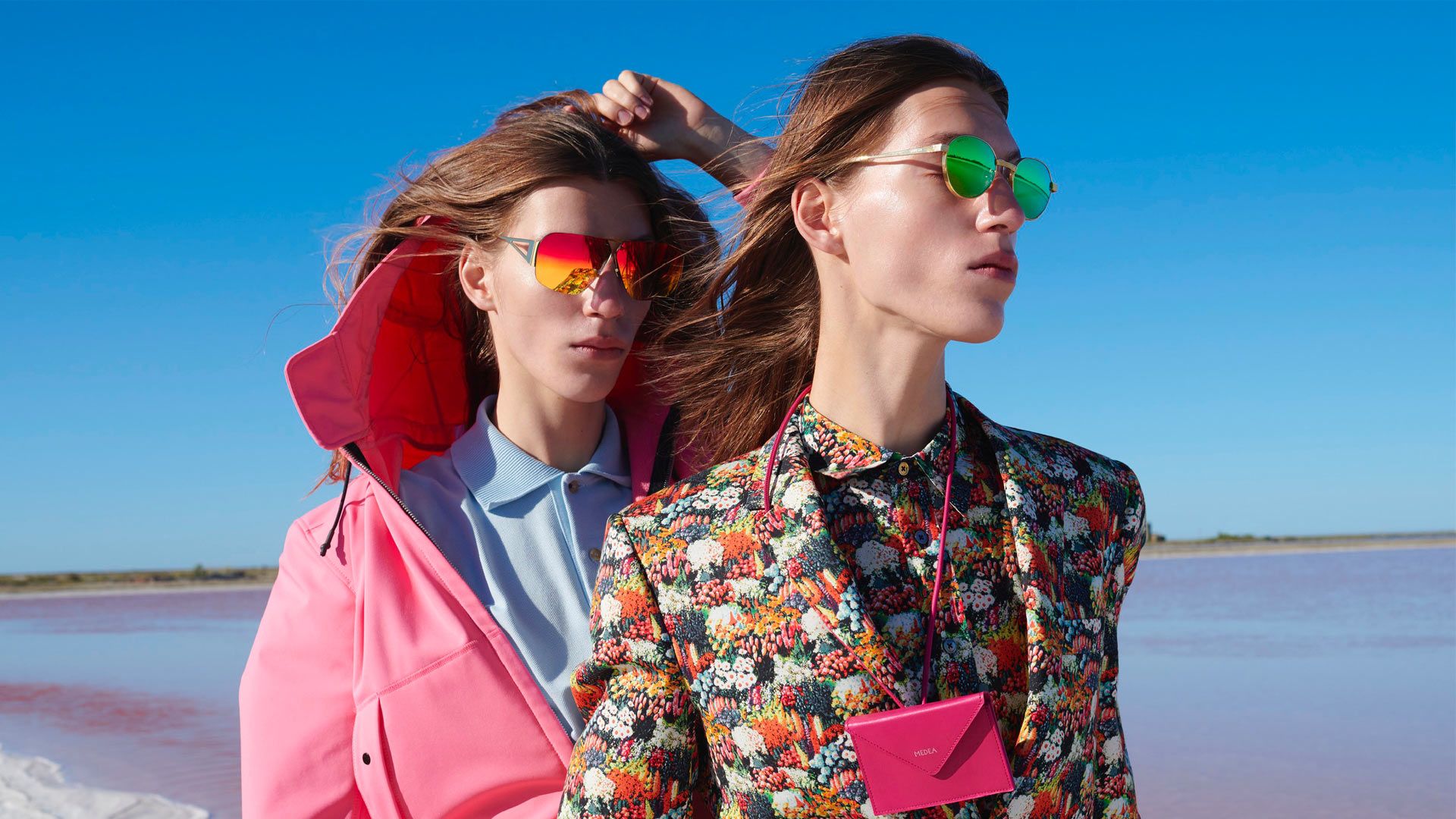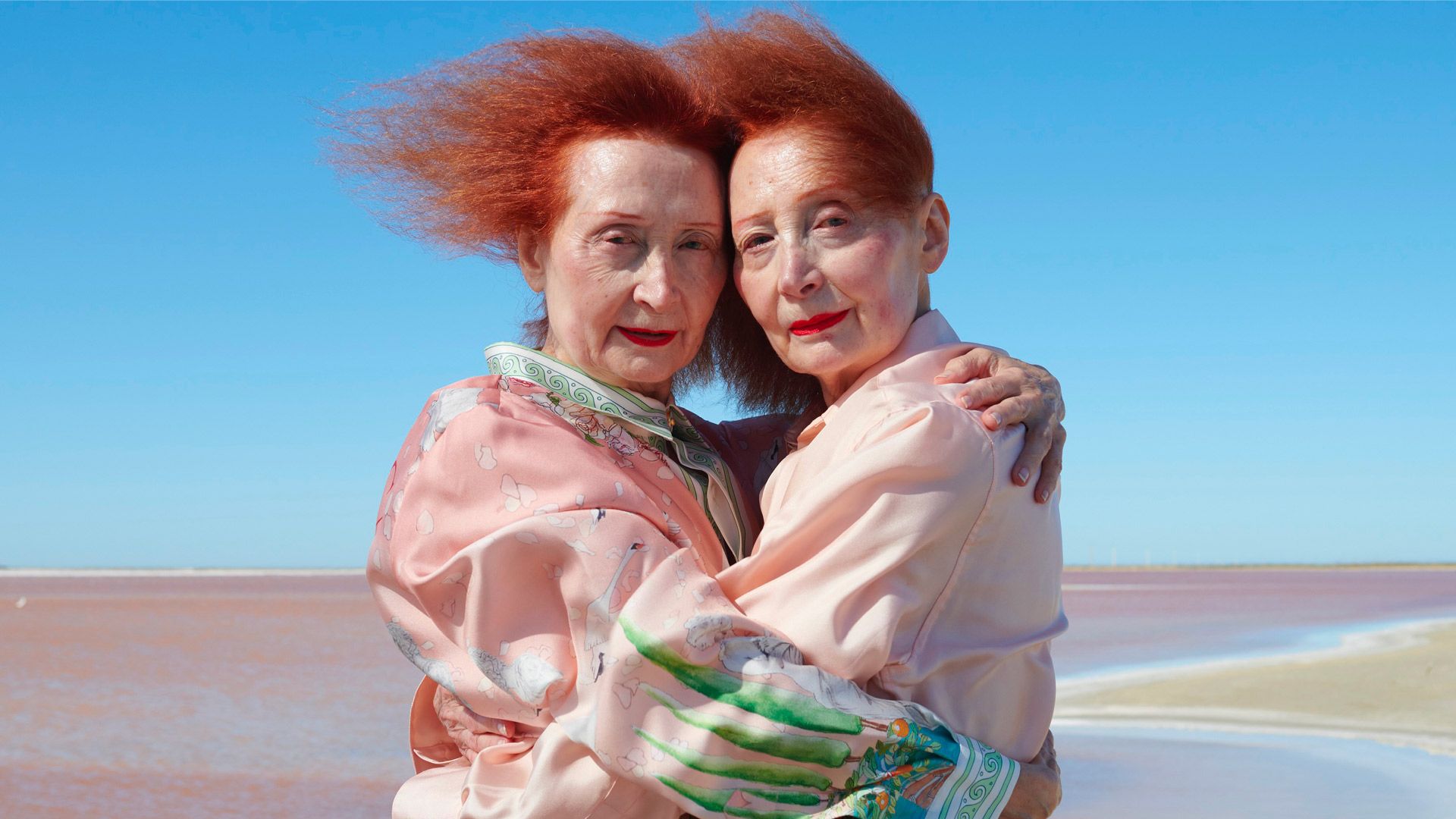-
Twins: From the Other Side of the Looking Glass
Creative and Styling Director, Yann Weber. Photographer, Patrick Weldé. Producer, Guillaume Folliero de Luna. Models, Kacper & Oskar, Jocelino & Grzelak Warren, Amalie & Cecilie Moosgaard, Monette & Mady Malroux. Hairstylist, Olivier Schawalder. Make up artist, Tiziana Raimondo.

Pink Jacket Jacquemus, Green Sweatshirt Off White, Sunglasses Christian Cowan.
Right:Orange Sweatshirt Off White, Sunglasses The Calabasas Orange Christian Cowan.
Since Antiquity, a whole cultural imaginary has developed around the figure of the twin. The stories of the Dioscuri, Romulus and Remus, Cain and Abel, or Jacob and Esau are recited time and time again. Divine or human, sometimes demiurges, protectors, warriors or navigators, the twins' destiny is often exceptional, but their fates are always intertwined. The image of the twin thus drinks from the well of phantasmagories, often excessive in their nature. The idea that two beings resembling each other are linked in their actions, thoughts and emotions is fascinating. For behind the story of the twins there lies that hall of mirrors — the ecstatic or fearsome prospect of the double. Whether they are identical twins, complementary and united beings like Castor and Pollux, or even monstrous rivals like Romulus and Remus, these myths ultimately interrogate themes of identity and difference. If twins reside so deeply in the collective imagination, it is because the question of the double refers above all to the quest for identity and singularity. The double, above all, questions the "I".

Full look, Serapis Maritime, Leather Boots, Alyx.
Right:Full look, Serapis Maritime, Leather Elton Boots, Pierre Hardy.
In 1949, psychoanalyst Jacques Lacan elaborated the theory of the "mirror stage", that is, the idea that somewhere between 6 and 18 months of age a child recognizes his or her image in the mirror as being his or her own and begins at that moment to structure himself or herself according to an identity upon which his or her psychic construction will be founded. This stage is thus the beginning of the formation of the self, or at least the ego. But what about twins and their double? How can one construct oneself from childhood onward with the knowledge that one is not unique? A reflection all the more complex as the construction and individualization of the self passes through the gaze of the other. "As the myth of Narcissus reminds us: in order to live, to construct oneself, to think about oneself and to heal some of one's wounds, the subject must go through the other. This original and founding link will subsequently permeate each of his acts, choices, thoughts or emotions. It will permeate them, though not totally determine them, because in the meantime, processes of subjectivation and transformation will have taken place," explains Régine Scelles in her Reflections on the Fraternal Double (L'Esprit du Temps, 2004). Twins are thus linked from a very young age in their relationship to the world and to themselves. They are built as mirrors, although each develops his or her own individuality as they mature. According to the Greek writer Pausanias, Narcissus does not seek his own reflection in the water, but rather that of his missing twin sister — an originary link that would be sacred and immutable.
Twinhood intrigues as much as it troubles, and a myriad of stories and incarnations have illustrated this throughout history. Particularly in recent years, twins have taken center stage, as evidenced by the growing number of models and influencers who derive their notoriety from their doubles. From New York to Paris, the Japanese Suzuki twins, with their 273,000 followers on Instagram, are in the limelight at international Fashion Weeks and sit side by side in the front row at the biggest shows. With their fuchsia bobs and impeccable outfits, the two sisters play with their image by posing in identical ensembles, often from labels such as Gucci or Moschino. In fact, they were the muses for the 2018 Moschino x H&M campaign. Equally adored, twins Ruth and May Bell exhibit their sisterly attitude by cultivating the art of difference. On the one hand, Ruth — androgynous looking and sporting short hair — advances with a sure step on the catwalks around the world, from Saint Laurent to Lanvin and Versace. On the other hand, May — more discreet with long, fine hair — posed alongside her for Burberry and Dior, and then solo for the cover of Vogue Italy. Fashion is crazy about this duo and their singular clout.

Pink Jacket Stone Island, Printed Blue Cotton Polo Lanvin.
Right:Full look Paul Smith, Necklace Medea, Sunglasses Gucci.
At a moment when society is in the midst of a reckoning with identity and gender, the figure of the twin also invites us to reflect upon notions such as singularity, otherness, and inclusiveness. In 2005, twins Mady and Monette Malroux walked for John Galliano at Paris Fashion Week in a show featuring senior models. We literally were seeing double with these two Parisian women, also seen in the film Amélie by Jean-Pierre Jeunet. United on stage and in the city, the two sisters have chosen to live and work together. The Gucci "Accidental Influencers" campaign also highlighted the duo in February 2020, when Alessandro Michele featured a group of doubles dressed almost identically in everyday scenes. Created by the British photographer and director Max Siedentopf, the series acts as an absurdist narrative where illusion and reality meet. This concept is also found in Thom Browne's Fall/Winter 2020-2021 presentation, which features 33 assorted couples advancing at the same pace, regardless of age or gender — like twins. An optical illusion that blurs the boundaries between the men's and women's wardrobes with perfect balance.
If twins were previously seen as a single entity in the common imagination, developmental psychologist René Zazzo turned this vision upside down in the 1980s. In 1984, he published The Twin Paradox (Stock), which propelled him to the popular rank of "Monsieur Twins". By studying their psychology for years, this disciple of Henri Wallon became interested in the differences that exist between true monozygotic twins, rather than focusing on their similarities. A "Eureka" moment in twin psychology: far from being "identical," these twins formed a couple with "a more-or-less stable distribution of tasks and daily activities." By studying the dynamics that united them, he sought to understand the genesis of identity and to answer the quintessential question: how can two apparently "identical" beings construct their respective singularity? In the end, he found a response to the existential question: how does one become oneself? From then on, twins were no longer perceived as one and the same entity, but as two distinct and singular beings.

However, many fantasies about twins remain anchored in the popular imagination due to the power of different literary and cinematographic narratives, such as the idea that they have telepathic abilities. Indeed, fashion, literature, art, and cinema have always played on mirror games. In the early 1980s, the world was haunted by the image of the terrifying twins in blue dresses in Stanley Kubrick's The Shining, which was inspired by Diane Arbus' "Identical Twins." The double can indeed provoke a feeling of unease and strangeness, while also constituting a real dramaturgical device. Here, myth meets reality and magic prevails over science, though it remains true that some people share connections that may seem inexplicable.
Recent studies also show that since the 1970s, the number of twin births has doubled in developed countries. If the hereditary factor remains one of the major causes of twins, the increase in the age of the mother or the growing use of in-vitro fertilization may also have given rise to this "twin boom." The phenomenon has been closely studied by scientists, and it seems to have reached a plateau in some places: a quarter of the countries studied have seen their figures decrease, such as in the Netherlands, Denmark, Norway, Finland, and the Czech Republic. In France, while this boom does not appear to be over quite yet, Doctor Claude Imbert raises yet another question in his book Un seul être vous manque... : Did you have a twin? (Visualisation holitique, 2004). Here, he focuses on scientific studies demonstrating that a minimum of 12 to 15% of pregnancies are initially twinned. Exploring those that were interrupted, the author discusses the psycho-emotional consequences and the unconscious grief that this loss might cause — a metaphysical reflection on how the twin question once again interrogates our most profound psychological notions, probing the spirit of these genetic doubles. The fascination with twins should hence be expected to continue, and to nourish a myriad of studies, myths, and fantasies.